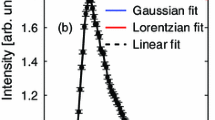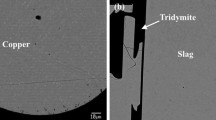Abstract
The oxidation balance is arguably one of the most important parameters during pyrometallurgical processes. In many cases, iron is the most abundant multivalent element present in silicate slags. Within these molten oxide mixtures, the oxygen balance is dominated by the relative fractions of Fe3+ and Fe2+ present. Measuring the concentration of ferrous and ferric iron in quenched slags can provide useful information about the oxidation state of the liquid slag at the moment of freezing. These measurements are not always straightforward, especially in lead-rich slags, as present in modern secondary smelting processes. Building on previous work, this article aims towards a practical and reliable methodology for determining the Fe3+ concentration in lead-rich silicate slags using continuous wave electron paramagnetic resonance (CW-EPR). The method is demonstrated for different Fe3+/\(\Sigma \)Fe ratios and a basic model is proposed that relates the slag composition to the EPR spectrum, optimized for a high-lead ternary PbO–SiO2–Fe2O3 slag.
Graphical Abstract













Similar content being viewed by others
References
Jak E, Degterov S, Hayes PC, Pelton AD (1998) Thermodynamic optimisation of the systems CaO-Pb-O and PbO-CaO-SiO2. Can Metall Q 37(1):41–47. https://doi.org/10.1016/S0008-4433(98)00004-4
Shevchenko M, Jak E (2017) Experimental phase equilibria studies of the Pb-Fe-O system in air, equilibrium with metallic lead and at intermediate oxygen potentials. Metall Mater Trans B 48(6):2970–2983. https://doi.org/10.1007/s11663-017-1069-7
Shevchenko M, Jak E (2018) Experimental phase equilibria studies of the PbO-SiO2 system. J Am Ceram Soc 101(1):458–471. https://doi.org/10.1111/jace.15208
Shevchenko M, Jak E (2019) Thermodynamic optimization of the binary systems PbO-SiO2, ZnO-SiO2, PbO-ZnO, and ternary PbO-ZnO-SiO2. Calphad 64:318–326. https://doi.org/10.1016/j.calphad.2019.01.011
Shevchenko M, Jak E (2019) Thermodynamic optimization of the PbO-FeO-Fe2O3-SiO2 system. Calphad. https://doi.org/10.1016/j.calphad.2019.101670
Shishin D, Hidayat T, Sultana U, Shevchenko M, Jak E (2020) Experimental study and thermodynamic calculations of the distribution of Ag, Au, Bi, and Zn between Pb metal and Pb-Fe-O-Si slag. J Sustain Metall 6(1):68–77. https://doi.org/10.1007/s40831-019-00257-3
Jak E, Hayes PC, Bale CW, Degterov S (2007) Application of FactSage thermodynamic modeling of recycled slags (Al2O3-CaO-FeO- Fe2O3-SiO2-PbO-ZnO) in the treatment of wastes from end-of-life-vehicles. Int J Mater Res 98(9):872–878. https://doi.org/10.3139/146.101546
Zhou Z, Yuan T, Hu Z, Liu R, Xia Y, Wang S (1986) Mössbauer studies on iron in polybasic silicate glass. J Non-Cryst Solids 84:34–44. https://doi.org/10.1016/0022-3093(86)90760-X
Bingham PA, Parker JM, Searle T, Williams JM, Fyles K (1999) Redox and clustering of iron in silicate glasses. J Non-Cryst Solids 253:203–209. https://doi.org/10.1016/S0022-3093(99)00361-0
Zhang HL, Cottrell E, Solheid PA, Kelley KA, Hirschmann MM (2018) Determination of Fe3+/ΣFe of XANES basaltic glass standards by Mössbauer spectroscopy and its application to the oxidation state of iron in MORB. Chem Geol 479:166–175. https://doi.org/10.1016/j.chemgeo.2018.01.006
Wilke M, Farges F, Petit P-E, Brown GE, Martin F (2001) Oxidation state and coordination of Fe in minerals: an Fe K-XANES spectroscopic study. Am Miner 86:714–730. https://doi.org/10.2138/am-2001-5-612
Berry AJ, O’Neill HSC, Jayasuriya KD, Clampbell SJ, Foran GJ (2003) XANES calibrations for the oxidation state of iron in a silicate glass. Am Miner 88:967–977. https://doi.org/10.2138/am-2003-0704
Magnien V, Neuville DR, Cormier L, Mysen BO, Briois V (2004) Kinetics of iron oxidation in silicate melts: a preliminary XANES study. Chem Geol 213:253–263. https://doi.org/10.1016/j.chemgeo.2004.08.047
Proost K, Janssens K, Wagner B, Bulska E, Schreiner M (2004) Determination of localized Fe2+/Fe3+ ratios in inks of historic documents by means of µ-XANES. Nucl Instrum Methods Phys Res B 213:723–728. https://doi.org/10.1016/S0168-583X(03)01693-8
Giuli G, Eeckhout SG, Paris E, Koeberl C, Pratesi G (2005) Iron oxidation state in impact glass from the K/T boundary at Beloc, Haiti, by high-resolution XANES spectroscopy. Meteorit Planet Sci 40(11):1575–1580. https://doi.org/10.1111/j.1945-5100.2005.tb00132.x
Cottrell E, Kelley KA, Lanzirotti A, Fischer RA (2009) High-precision determination of iron oxidation state in silicate glasses using XANES. Chem Geol 268(3–4):167–179. https://doi.org/10.1016/j.chemgeo.2009.08.008
Ceglia A, Nuyts G, Meulebroeck W, Cagno S, Silvestri A, Zoleo A, Nys K, Janssens K, Thienpont H, Terryn H (2015) Iron speciation in soda-lime-silica glass: a comparison of XANES and UV-vis-NIR spectroscopy. J Anal At Spectrosc 30(7):1552–1561. https://doi.org/10.1039/c5ja00046g
Darby Dyar M, McCanta M, Breves E, Carley C, Lanzirotti A (2016) Accurate predictions of iron redox state in silicate glasses: a multivariate approach using X-ray absorption spectroscopy. Am Mineral 101:744–747. https://doi.org/10.2138/am-2016-5555
Goldman DS (1983) Oxidation equilibrium of iron in borosilicate glass. J Am Ceram Soc 66(3):205–209. https://doi.org/10.1111/j.1151-2916.1983.tb10018.x
Knipping JL, Behrens H, Wilke M, Göttlicher J, Stabile P (2015) Effect of oxygen fugacity on the coordination and oxidation state of iron in alkali bearing silicate melts. Chem Geol 411:143–154. https://doi.org/10.1016/j.chemgeo.2015.07.004
Henke B, Gullikson E, Davis J (1993) X-ray interactions: photoabsorption, scattering, transmission, and reflection at E=50-30000 eV, Z=1-92. At Data Nucl Data Tables 54(2):181–342. https://doi.org/10.1006/adnd.1993.1013
Lawrence Clever H (1980) The solubility of some sparingly soluble lead salts: an evaluation of the solubility in water and aqueous electrolyte solution. J Phys Chem Ref Data 9:751–784. https://doi.org/10.1063/1.555628
Zoleo A, Brustolon M, Barbon A, Silvestri A, Molin G, Tonietto S (2014) Fe(III) and Mn(II) EPR quantitation in glass fragments from the pallaeo-Christian mosaic of St. Prosdocimus (Padova, NE Italy): Archaeometric and colour correlations. J Cult Herit 16(3):322–328. https://doi.org/10.1016/j.culher.2014.07.005
Castner T, Newell GS, Holton WC, Slichter CP (1960) Note on the paramagnetic resonance of iron in glass. J Chem Phys. https://doi.org/10.1063/1.1730779
Abragam A, Bleaney B (1970) Electron paramagnetic resonance of transition ions. Clarendon Press, Oxford
Vercamer V, Lelong G, Hijiya H, Kondo Y, Galoisy L, Calas G (2015) Diluted Fe3+ in silicate glasses: structural effects of Fe-redox state and matrix composition. An optical absorption and X-band/Q-band EPR study. J Non-Cryst Solids 428:138–145. https://doi.org/10.1016/j.jnoncrysol.2015.08.010
H. Gokturk (2017) Measurement of transition metals in soda-lime-silicate glasses by using electron spin resonance (ESR) spectroscopy, Ph.D. thesis, Graduate School of Engineering and Sciences of ˙Izmir Institute of Technology
Eaton GR, Eaton SS, Barr DP, Weber RT (2010) Quantitative EPR. Springer, New York. https://doi.org/10.1007/978-3-211-92948-3
Cnockaert V, Maes K, Bellemans I, Crivits T, Vrielinck H, Blanpain B, Verbeken K (2020) Quantification of the Fe3+ concentration in lead silicate glasses using Xband CW-EPR. J Non-Cryst Solids 536:120002. https://doi.org/10.1016/j.jnoncrysol.2020.120002
Bale CW, Bélisle E, Chartrand P, Decterov SA, Eriksson G, Gheribi AE, Hack K, Jung IH, Kang YB, Melançon J, Pelton AD, Petersen S, Robelin C, Sangster J, Van Ende M-A (2016) FactSage thermochemical software and databases, 2010–2016. Calphad 54:35–53. https://doi.org/10.1016/j.calphad.2016.05.002
Kacem IB, Gautron L, Coillot D, Neuville DR (2017) Structure and properties of lead silicate glasses and melts. Chem Geol 461:104–114. https://doi.org/10.1016/j.chemgeo.2017.03.030
Bogomolova U, Jachkin V, Lazukin V, Shmucler V (1978) The EPR spectra of some transition ions in lead-silicate glasses. J Non-Cryst Solids 27:427–435
Mendiratta SK, De Sousa EG (1988) Clustering and g = 4.3 ESR peak in iron containing glasses. J Mater Sci Lett 7:733–734. https://doi.org/10.1007/BF00722083
Rao K, Rao B (1985) Electron spin resonance of transition metal ions in glasses. Proc Indian Acad Sci 95(296):169–188. https://doi.org/10.1007/BF02839726
Zadrozny JM, Freedman DE (2015) Qubit control limited by spin—lattice relaxation in a nuclear spin- free iron(III) complex. Inorg Chem 54:12027–12031. https://doi.org/10.1021/acs.inorgchem.5b02429
Ariciu A, Woen DH, Huh DN, Nodaraki LE, Kostopoulos AK, Goodwin CAP, Chilton NF, Mcinnes EJL, Winpenny REP, Evans WJ, Tuna F (2019) Engineering electronic structures to prolong relaxation times in molecular qubits by minimising orbital angular momentum. Nat Commun. https://doi.org/10.1038/s41467-019-11309-3
Acknowledgements
V. Cnockaert holds a Baekeland mandate (160207) from the Flanders Agency of Innovation & Entrepreneurship (VLAIO), supported by Umicore N.V. I. Bellemans holds a research Grant from the Research Foundation – Flanders (101096/12Z7720N).
Author information
Authors and Affiliations
Corresponding authors
Ethics declarations
Conflict of interest
On behalf of all authors, the corresponding author states that there is no conflict of interest.
Additional information
The contributing editor for this article was Sharif Jahanshahi.
Publisher's Note
Springer Nature remains neutral with regard to jurisdictional claims in published maps and institutional affiliations.
Rights and permissions
About this article
Cite this article
Cnockaert, V., Bellemans, I., Crivits, T. et al. Determination of the Fe3+/\({\varvec{\Sigma}}\)Fe Ratio in Synthetic Lead Silicate Slags Using X-Band CW-EPR. J. Sustain. Metall. 7, 519–536 (2021). https://doi.org/10.1007/s40831-021-00348-0
Received:
Accepted:
Published:
Issue Date:
DOI: https://doi.org/10.1007/s40831-021-00348-0




